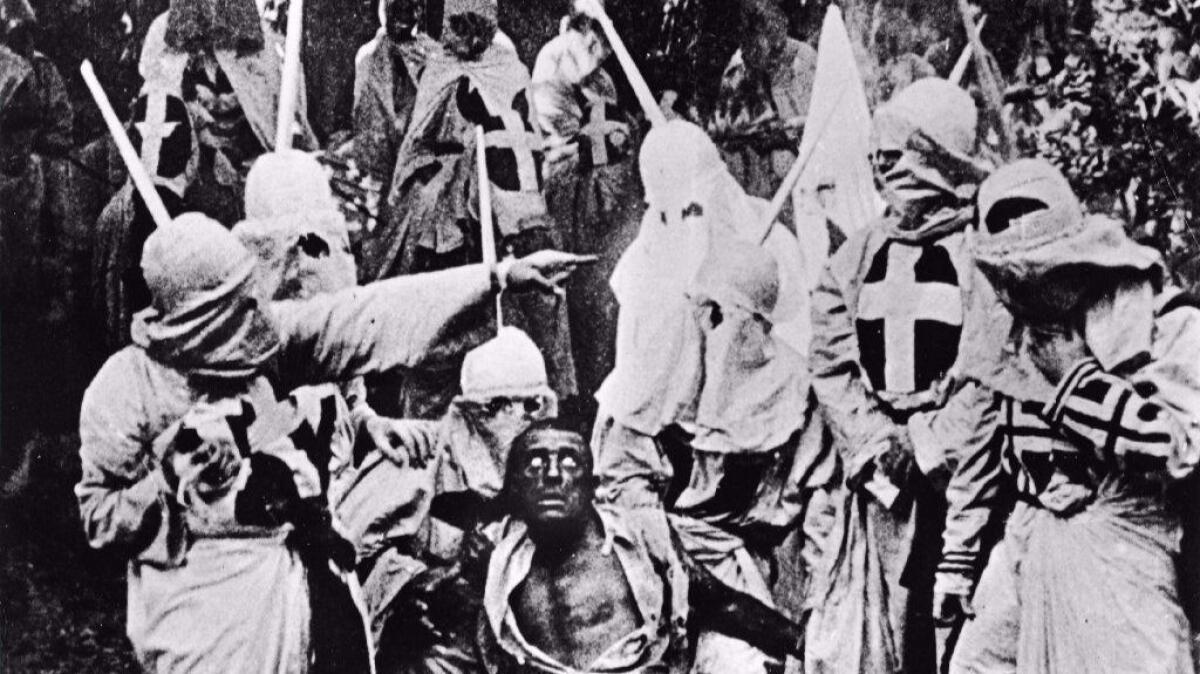Historical art or racist propaganda? How should Hollywood handle problematic classics like ‘Gone With the Wind’?
On the same night that white supremacist groups marched with torches and Nazi chants on the campus of the University of Virginia in Charlottesville in preparation for the next day’s Unite the Right rally, the Orpheum Theatre in Memphis, Tenn., screened “Gone With the Wind” as part of its annual summer classics series.
Two weeks later, after receiving many online complaints from those who took issue with the picture’s romanticized view of slavery, theater officials announced that it would no longer be part of that series.
This sparked another round of complaints — with its 10 Oscars, including the first one for a black actress (Hattie McDaniel), many argued that “Gone With the Wind” is a cinematic masterpiece, its sins more easily forgiven, or contextualized, than a statue of the judge behind the Dred Scott decision.
Suddenly, Hollywood, three years into the #OscarsSoWhite campaign with its continued calls for diversity in front of and behind the camera, was forced to confront a larger conversation: How exactly does this nation grapple with its sordid past of overt and institutionalized racism?
“You can’t sweep history under the rug,” said Todd Boyd, a professor of cinema and media studies at USC. “A lot of it is not pretty and it may contradict the ways some people see things in contemporary society… But it’s important to have context whenever you’re viewing material of this kind. Otherwise, people can embrace and celebrate it without dealing with the whole truth.”
Recognize whatever artistry you want to… but that doesn’t deny you from also recognizing the racism.
— Todd Boyd
“As an organization whose stated mission is to ‘entertain, educate and enlighten the communities it serves,’ the Orpheum cannot show a film that is insensitive to a large segment of its local population,” Brett Batterson, president of the theater group, said last week in a statement.
In an interview with the Memphis daily newspaper the Commercial Appeal, he noted that the appropriateness of screening the film had been discussed “every year” but that “the social media storm this year really brought it home.”
But if relics of yesteryear find themselves in jeopardy in states across the country, how will this affect movies in the cinematic canon that might be seen as similarly problematic? Films ranging from D.W. Griffith’s silent-era “The Birth of a Nation” (in which members of the Ku Klux Klan are portrayed as heroes) and Nazi sympathizer Leni Riefenstahl’s “Triumph of the Will” have long been subject to debate.
But what about less obvious targets like Blake Edwards’ “Breakfast at Tiffany’s,” in which Mickey Rooney plays a cartoonishly rendered Asian American character, or Bernardo Bertolucci’s “Last Tango in Paris,” which ignited a firestorm last year when details about the filming of the infamous “butter” scene involving Maria Schneider resurfaced, raising concerns about consent.
While these pictures can be considered art and each has historical significance, they can also be recognized as sentimentalizing or implicitly endorsing behavior now thought to be reprehensible.
“Two things can be true at the same time, [because] art doesn’t create itself,” said Boyd, noting that “the foundation upon which Hollywood was built” — “The Birth of a Nation” — “is nothing less than racist propaganda. Recognize whatever artistry you want to… but that doesn’t deny you from also recognizing the racism.”
These conversations have been taking place in Hollywood for years now — for example, when the American Film Institute surveyed industry leaders in 1998 for its first list of the 100 greatest films of all time, “The Birth of a Nation” landed at No. 44. When the survey was conducted again close to a decade later, Griffith’s film fell off the list entirely, while his follow-up, “Intolerance,” popped up at No. 49. (And Spike Lee’s heralded “Do the Right Thing” was a newcomer at No. 97.) “Gone With the Wind” ranked in the top 10 both times.
Stephane Dunn, a film historian and director of the cinema, television and emerging media studies program at Morehouse College in Atlanta, agreed, noting that she “deplores” “The Birth of a Nation” in terms of its racial themes.
“But there is no question that D.W. Griffith pushed modern moviemaking ahead and anticipated what we know as modern cinema,” she said. “He showed the technical possibilities of film; there is no denying that. But people are perfectly correct to recognize and condemn the racist story that is at its core, and that of ‘Gone With the Wind.’”
Dunn believes that such films should still be shown, but that considering the broader socio-political environment, a greater responsibility lies with those putting on screenings.
“You don’t show those films without having a discussion that follows,” she said. “And you’re careful with that conversation, because it should not be like a walk in the park through classic memories.”

Dunn and Boyd agreed that any post-screening Q&As and talk-backs should involve, in part, the pictures’ implications during the time they were originally released. In the case of “Gone With the Wind,” they said, it should be noted that McDaniel was not allowed to attend its Atlanta premiere because of her race. Additionally, when she attended the Oscar ceremony, she was seated away from her white castmates at a table on the far side of the room in the segregated hotel.
“That’s the type of discussion to be having,” Dunn said, “and about how the aftermath of a very virulent white supremacist society brought a romanticization of the old power guard. The conversation should very directly address that [the film has a] nostalgic demeanor about this mythology of an Old South.”
But what about productions going forward — How much should the possibility of protest affect new art? After the recent announcement of “Confederate,” an upcoming HBO series set in an alternate reality where the Confederacy successfully seceded and slavery remains legal, a social media campaign against the still-in-development show, dubbed #NoConfederate, followed within 24 hours.
“What we have always said with #NoConfederate is that there is more than enough [depictions of enslaved people],” said April Reign, one of the creators of the campaign and the mastermind behind #OscarsSoWhite. “Books, films, television — there is no need to create more, because you will get a full picture of how insidious the enslavement of people was in these older works. The commodification of black pain for white enjoyment must end.”
As for existing works, Reign agreed that they should continue to be viewed, though “everyone now has a responsibility to provide additional information so that people don’t walk out the theater empty-handed.” She highlighted the 2016 remake of the landmark TV series “Roots” as a prime example that had educational resources built into its History channel airing.
“If what we do is stop showing these painful-at-times depictions of slavery, then we don’t have anything left,” she said. “Then someone will say, ‘We don’t have anything that shows these graphic depictions and we need to create more.’”
Get your life! Follow me on Twitter (@TrevellAnderson) or email me: trevell.anderson@latimes.com.
More to Read
Only good movies
Get the Indie Focus newsletter, Mark Olsen's weekly guide to the world of cinema.
You may occasionally receive promotional content from the Los Angeles Times.











